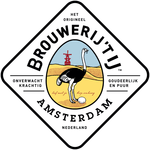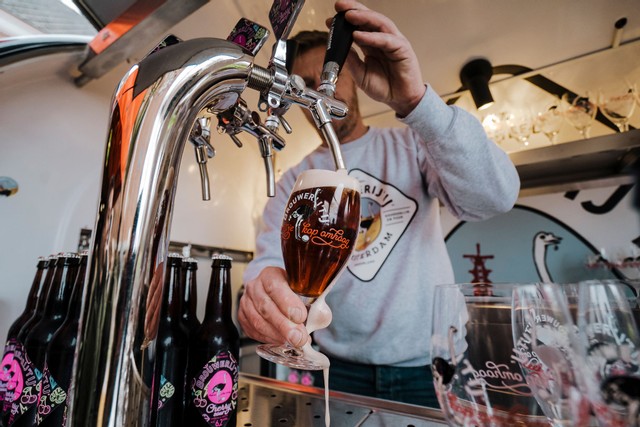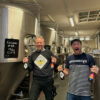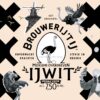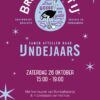At Brouwerij ‘t IJ we have had a great love for the beers of our Belgian colleagues from thevery beginning. Kaspar Peterson, the founder of our brewery, got hooked on it when he was still touring Belgium as a bass player and when he was a brewer himself once he regularly went back there. He rummaged through breweries and talked to the people who worked there. This resulted, among other things, in a double and a triple with sounding Flemish names and a wheat beer that contains the necessary herbs and lemon entirely in the Belgian style. They form an important part of our DNA and with that we now have a few Belgian beer styles pretty well in the fingers. But there is still plenty for us to discover within the various beercultures that Belgium has to offer. For example, we would always like to make such a typical sweet fruit beer again. We therefore decided to go south again and sample inspiration with Belgian colleagues.

This time we let Marc Coesens talk about cherry beer and other sour brews. Coesens is responsible for the ins and outs of Liefmans, a brewery in the East Flemish town of Oudenaarde. Beer has been brewed there since the Middle Ages on the Scheldt. That location had its drawbacks in that period. “Then it was the case that Flanders did not have permission to use hops,” explains Coesens. “ Hops were only intended for the abbeys and for medicinal use.” Too bad for those who brewed outside monastery walls because the use of hops protects beer better against the influence of bacteria. “If you don’t use hops, that beer will quickly acidify.” The beer of the brewery that is now called Liefmans had a pretty sour taste from time immemorial. When the Vlaamse brewers were allowed to use hops, it turned out that there were also disadvantages . “They quickly realized that the sour beer got a totally different taste as a result.” The forerunner of the current brewery decided to cherish the characteristic acidity and use slechts in moderation hops. “That’s why we still make sour beers at Liefmans. Those beers all sour.” While most breweries are in constant battle with bacteria, they are very welcome at Liefmans. “Our bier is still fermented in open yeast vats. They are still made of copper and cannot be sterilized. They can be cleaned, but we do not sterilize them because there are lactic acid bacteria in our brewery.” They are of course invisible so Coesens has no idea what exactly they are. “Against the walls? In the pipes? In any case, they are intertwined with our brewery and are always present in our beer.”
The wort, the unfermented beer, is made elsewhere and then driven to Oudenaarde. “We will then sow them with our own yeast,” says Coesens. “We harvested that yeast from the previous brew. That way we maintain that mixture of yeast and bacteria, especially lactic acid bacteria. That is what we mean when we say ‘we make beers from mixed gisting’. Yeast with lactic acid bacteria in it. Those lactic acid bacteria that come in spontaneously . We don’t have to do anything for that. They are in the environment and they cause the beer to sour.”
All the beer at Liefmans ferments in this way. The basis of a small part of the beers, the Goudenband and Oud Bruin, is a bit darker but about 90% is blond. “It looks like lager but it’s sour,” explains the brewmaster. “ That is basically the basis for a lot of other beers, such as the Fruitesse and the cherry beer.”
For that cherry beer, Liefmans makes mixtures of cherries and beer with which they then also mix the final beer, also called ‘stitches.’ This requires huge quantities of cherries, or (sour) cherries. Liefmans nowadays only uses the so-called gorsemkriek for this. “We used to have all kinds of kinds on different tanks and year after year it always turned out that those gorsems tasted the best.” What’s in it for him? “The cherry character that we want to achieve is best expressed with the gorsem,” says Coesens. “ Just a little more intense in acidity and a bit fuller in taste.” In Gingelom, in Belgian Limburg, Liefmans has had an extensive plantation planted for gorsemkrieken. “We buy between 60 and 100 tons at once and they harvest that there at the end of June, beginning of July.”
When the harvest is in, everything has to be processed at once. “We have beer and we buy cherries and we put them together”, Coesens summarizes the production process. Per 100 liters, about 15 to 20 kilos of cherries go into the tanks. The exact quantity depends on the quality of the harvest. “If they are very good cherries, then we put a little less into them. If the cherries are a bit flutter now, we will put in a little more cherries .” In some years, 2021 for example, the harvest is so disastrous that the cherry beer is hardly usable to mix with. “But we always have cherry beer from different vintages. We always keep a number of tanks of two to three or even five years. As a result, we can now mainly use cherry beer from 2020, 2019 and 2018, for example. So we should not have two of those disaster harvests in a row. But we can always make some adjustments if we are a little less satisfied with another vintage. Then that will always be fine. This way we can always bring mixtures to the desired level”. Liefmans regularly uses this opportunity. Sometimes there are three to five different vintages in one beer. “That is quite specific and special about our brewery, that we have such a large stock of cherry beer. But around the time of harvest , we also have to make sure that enough tanks are empty again. Beer is added, beer goes out, mixed and done. It’s a very dynamic movement in those tanks and that can’t be automated.”
The final cherry beer is therefore created by mixing the beer from different tanks. That mixing naturally requires knowledge of the taste and that requires the necessary proevand. “We go to taste on a fairly regular basis. Then we list the beer from different tanks and then we taste it. Then we look at: what are we going to use the next time we mix.” We were of course curious about the magic of that mixing process itself and so Marc Coesens took us to the tasting room of the brewery. There, the contents of different tanks can be mixed very easily via the taps. “We have the habit of taking a certain beer too aromatic or too sweet and then adding a bit of ordinary basic beer.” Our brewers discovered ‘experimentally’ in the café how to do that and that tasted like more. We also wanted this, such a Belgian cherry beer, but in its Amsterdam style. So we started working with cherry beer ourselves and tasted and mixed until we had a nice blend. A beer in which the Belgian tradition of careful ‘stung’ fruit beers and the firm character of ‘t IJ come together beautifully. It has become a lush cherry bithere. By describing the slightly sweet and mildly sour character as funky and that is why we just went full of disco on the label.



